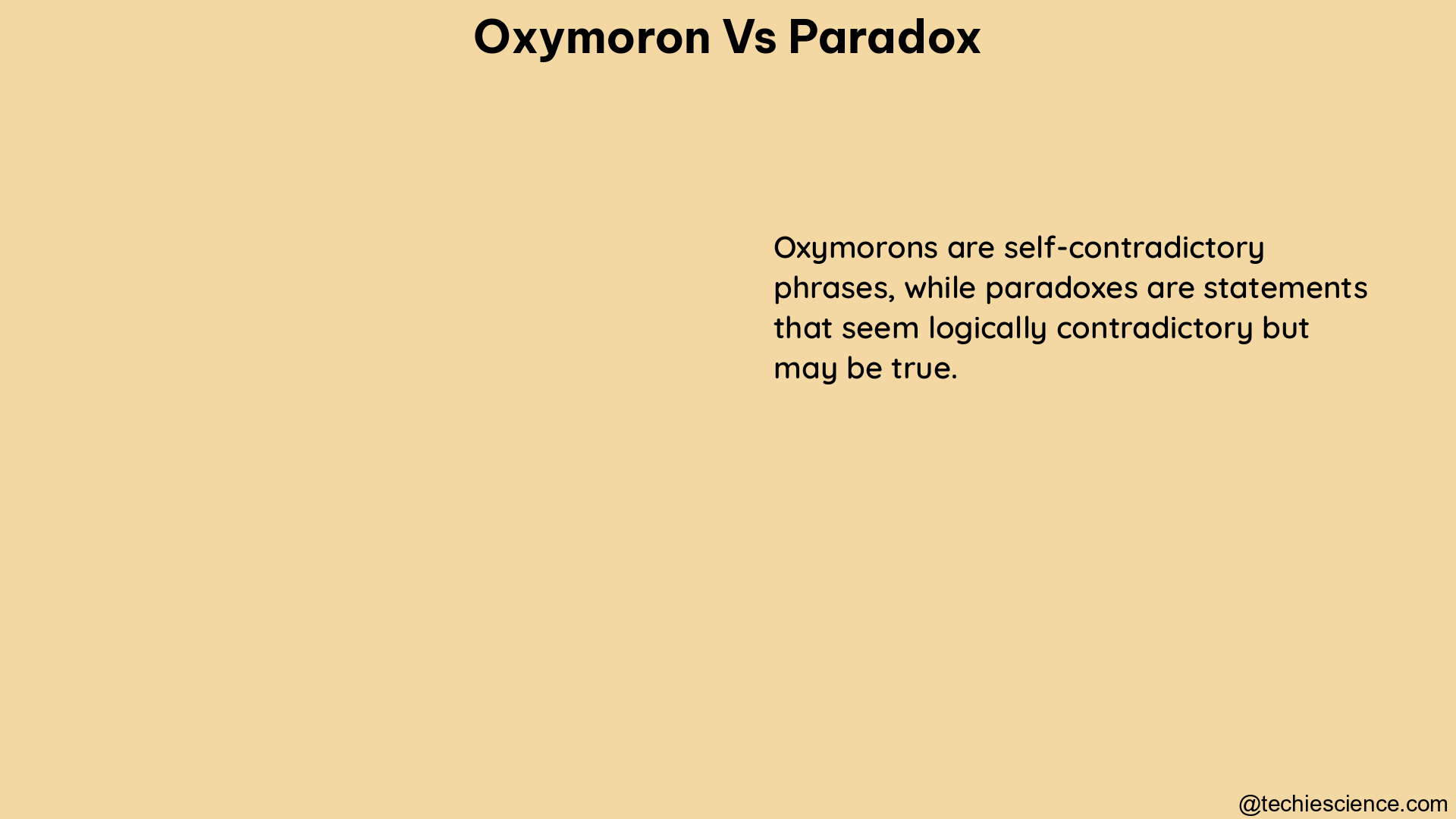Oxymorons and paradoxes are two literary devices that are often confused due to their similar nature of involving contradictions. However, these two concepts have distinct characteristics and serve different purposes in writing. This comprehensive guide will delve into the nuances of oxymorons and paradoxes, providing English students with a thorough understanding of these literary techniques.
Definition and Difference
Oxymoron
An oxymoron is a figure of speech that combines two words or phrases with opposite meanings. This juxtaposition of contradictory terms creates a unique rhetorical effect, often used to convey a complex idea or to evoke a specific emotional response. Examples of oxymorons include “jumbo shrimp,” “bitter sweet,” and “deafening silence.”
Paradox
A paradox is a statement or situation that appears to be self-contradictory but often reveals a deeper truth or insight. Paradoxes can be logical contradictions or seemingly impossible scenarios that challenge conventional thinking. Examples of paradoxes include “This sentence is false,” “All animals are equal, but some are more equal than others,” and “The only constant in life is change.”
Key Differences

- Level of Contradiction:
- Oxymoron: The contradiction occurs on a semantic level, where two words with opposite meanings are combined.
-
Paradox: The contradiction occurs on a logical level, often involving a deeper truth or insight that challenges conventional understanding.
-
Length and Structure:
- Oxymoron: Typically a short phrase of two or three words.
-
Paradox: Can be a single statement or a longer scenario.
-
Purpose:
- Oxymoron: Used to create a rhetorical effect or to convey a complex idea.
- Paradox: Used to reveal a deeper truth or insight, often challenging conventional thinking.
Examples and Usage
Oxymoron Examples
- “Jumbo shrimp” (combines large and small)
- “Bitter sweet” (combines opposing emotions)
- “Deafening silence” (combines sound and silence)
- “Clearly confused” (combines clarity and confusion)
- “Awfully good” (combines negative and positive evaluations)
Paradox Examples
- “This sentence is false” (logical contradiction)
- “All animals are equal, but some are more equal than others” (reveals a deeper truth about equality)
- “The only constant in life is change” (reveals a deeper truth about the nature of life)
- “I know that I know nothing” (Socratic paradox about the nature of knowledge)
- “The more you know, the less you understand” (reveals a deeper truth about the limits of knowledge)
Grammatical Specification
Oxymoron
- Typically consists of two words or phrases with opposite meanings.
- Often used as an adjective or adverb to describe a situation or idea.
- Examples: “Jumbo shrimp,” “Bittersweet,” “Deafening silence”
Paradox
- Can be a single statement or a longer scenario.
- Often involves a logical contradiction or a seemingly impossible scenario.
- Examples: “This sentence is false,” “All animals are equal, but some are more equal than others,” “The only constant in life is change”
Theoretical Explanation
Oxymorons and paradoxes both involve contradictions, but they serve different purposes and have different structures. Oxymorons are used to create a rhetorical effect or convey a complex idea by combining two words with opposite meanings. Paradoxes, on the other hand, are used to reveal a deeper truth or insight by presenting a logical contradiction or a seemingly impossible scenario.
The use of oxymorons and paradoxes in writing can be a powerful tool for authors, as they can challenge the reader’s assumptions and encourage deeper contemplation. Oxymorons can be used to add emphasis, create a sense of irony, or highlight the complexity of a situation, while paradoxes can be used to challenge conventional thinking and reveal new perspectives.
Understanding the differences between oxymorons and paradoxes is crucial for English students, as it can help them better appreciate the nuances of language and the ways in which contradictions can be used to convey meaning. By mastering the use of these literary devices, students can enhance their writing skills and develop a more sophisticated understanding of the power of language.
References
- ProWritingAid. (2022, June 11). Oxymoron vs Paradox: What’s the Difference? Retrieved from https://prowritingaid.com/oxymoron-vs-paradox
- English Stack Exchange. (2014, February 18). What is the relationship between Juxtaposition, Oxymoron, and Paradox? Retrieved from https://english.stackexchange.com/questions/152556/what-is-the-relationship-between-juxtaposition-oxymoron-and-paradox
- Reddit. (2023, January 15). Eli5: What is the difference between an oxymoron and a paradox? Retrieved from https://www.reddit.com/r/explainlikeimfive/comments/10cr3dj/eli5_what_is_the_difference_between_an_oxymoron/
- Scribbr. (n.d.). What is the difference between a paradox and an oxymoron? Retrieved from https://www.scribbr.com/frequently-asked-questions/what-is-the-difference-between-a-paradox-and-an-oxymoron/
- LaMarkable. (n.d.). Juxtaposition, Oxymoron & Paradox. Retrieved from http://lamarkable.weebly.com/juxtaposition-oxymoron–paradox.html

Hi! I am Bhabesh Sing. I have completed M.A in English, M.A in Vocal Music, and B.Ed. I am a creative writer. Currently, I am a Subject Matter Expert in English on this Platform.
Let’s connect through LinkedIn-https://www.linkedin.com/in/bhabesh-sing-660914ab